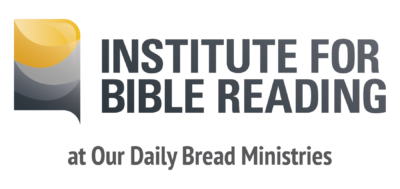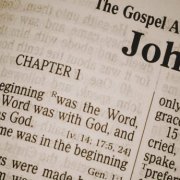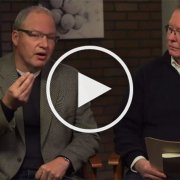How We Receive Guidance From the Bible’s Story
We talk a lot here about reading the Bible as a story.
We believe that’s good and appropriate, because that’s what the Bible actually is—a library of books that come together to tell a story and invite us into the big, beautiful drama of God’s redemption of all things.
But how exactly is something like a story useful? Is a story the kind of thing that can show us what to do? Can a story somehow have authority?
The “reference book” model of the Bible had an easier way to answer to these questions. How is the Bible useful? Well, you simply look up the topic you’re interested in, find the right passages, and there it is! Put a list of those texts together, add them up, and you’ve found your answer.
We can discover God’s wisdom on everything from marriage to money by doing topical searches.
So let’s take slavery, for example. Since slavery was a fundamental part of the ancient world, the Bible mentions it a lot. We can track down every reference, add up the teaching, and get the Bible’s message on slavery, right?
No, actually.
In his book The Civil War as a Theological Crisis, historian Mark Noll describes the intense argument 19th-century Christians had over the Bible’s position on slavery. Those advocating a biblical defense of slavery had the easier time defending their position. It’s not difficult to produce a long list of Bible verses that explicitly endorse or assume human slavery. So . . . the Bible teaches us that slavery is okay?
No, it doesn’t. But it takes reading the Bible a certain way in order to rightly discern what the Bible does teach.
It takes reading the Bible as a story. In particular, it takes reading the Bible as a story that moves in the direction of greater redemption, greater flourishing, greater life. The full revelation of God’s purposes for humanity can’t be simply lifted from a page just anywhere in the Bible. The Torah regulations on slavery are not God’s final answer on that question.
The Bible is a narrative that unveils more and more of God’s intentions over time. The story is heading towards the full realization of God’s intentions. To be specific, the story is heading towards Jesus.
It’s in the coming and work of the Messiah that we find the clearest and most definitive revelation of who God is and what he’s doing in the world. As that beautiful opening to the book of Hebrews has it: “And now in these final days, he has spoken to us through his Son. . . . The Son radiates God’s own glory and expresses the very character of God.” (NLT)
The life, death, resurrection, and powerful ascension of Jesus to the right hand of the Father, now with authority over all things—this is the centerpiece of the whole long and winding tale of the Scriptures. In the work of Jesus—sent by the Father and empowered by the Spirit—is where the story finds the redemption and restoration it’s been looking for.
♦♦♦
But wait. Doesn’t the New Testament continue to assume slavery in its teachings that come even after Jesus? Well, yes. The letters from the apostles to the churches do continue to give instructions to both slaves and masters within that relationship.
Huh?
The Bible clearly shows us a God who insists on working within our ongoing story to bring more light and more life over time.
Here’s the thing: the creation’s restoration in the Messiah is indeed the crux of everything. But as always, God does not simply intrude into human history in artificial ways.
The Bible clearly shows us a God who insists on working within our ongoing story to bring more light and more life over time. That is, God has committed to us—humans—as his creation-ruling partners. This was decided at the beginning, when God made us to his image-bearers, reflecting his good rule into the world.
As decisive as the Jesus event was, it didn’t fix everything overnight. The implications of his kingdom-launching still have to be worked out by those who join his world-transforming movement. The kingdom has come and is coming, but it has not yet fully arrived. The kingdom of God is like a seed that is planted.
Let’s stay with our slavery example for a moment. After the coming of Jesus, slavery did not simply disappear, not even among God’s own people. But then there’s Paul’s letter to Philemon. This one very short and simple letter to one slave-owning Christ-follower shows how God’s story with us does its work. Paul here shows us where the redemptive movement of the Bible’s narrative is headed. At the end of the day there is no place for one brother in Christ to own another brother in Christ. In the new humanity brought to us by the Second Adam we are all equal, members of one single worldwide family.
So don’t read the stories of the great patriarchs Abraham, Isaac, and Jacob, to get the perfect picture of God’s intention for marriage. (No, really, please don’t.) Don’t read the Torah to get God’s final answer on slavery. Don’t even read Paul’s letters to first-century churches to get the final word on church practices for today. All of the Bible was directed first of all to its original audiences. We find ourselves in a different place, later in the story, listening in on earlier conversations.
So the way a storiented Bible tells us what to do is to give us a deep, long look at a God who is slowly working to bring life to the world. He begins where people are, and then starts to bring them to a new place. The fact is, for example, that the Torah’s instructions on slavery were a redemptive advance over the common rules for slavery at that time. Slaves in ancient Israel had more rights and more protections. God’s story had begun to move things in a better direction.
Our job, then, is to discern where the redemptive story in Jesus is headed. This is more nuanced, and a bit more work, than simply looking up reference book answers like definitions in a dictionary. This requires mature, big-picture reading. This means Spirit-led reading in community as we work together to discern how to live this same redemptive story in our very different late modern setting.
Our job, then, is to discern where the redemptive story in Jesus is headed. This is more nuanced, and a bit more work, than simply looking up reference book answers like definitions in a dictionary.Click To TweetThe Bible invites us to look for gospel trajectories and redemptive endgames and then work to implement them in our own world. In the light of a dawning new creation we live as people of the coming Day, showing people what the future of the world looks like, not it’s past.
Grown-up Bible reading means asking: What stays the same in the biblical story? But also: What changes? The Bible gives us the light and revelation of God’s truth. It just doesn’t do it in a childish, simplistic, or artificial way. The only way this works is if we know the Scriptures deeply and well.
The Bible tells us what to do by telling us the Jesus-shaped story we’re a part of.
For further reading, see: Scripture and the Authority of God by N. T. Wright; Slaves, Women & Homosexuals by William Webb








